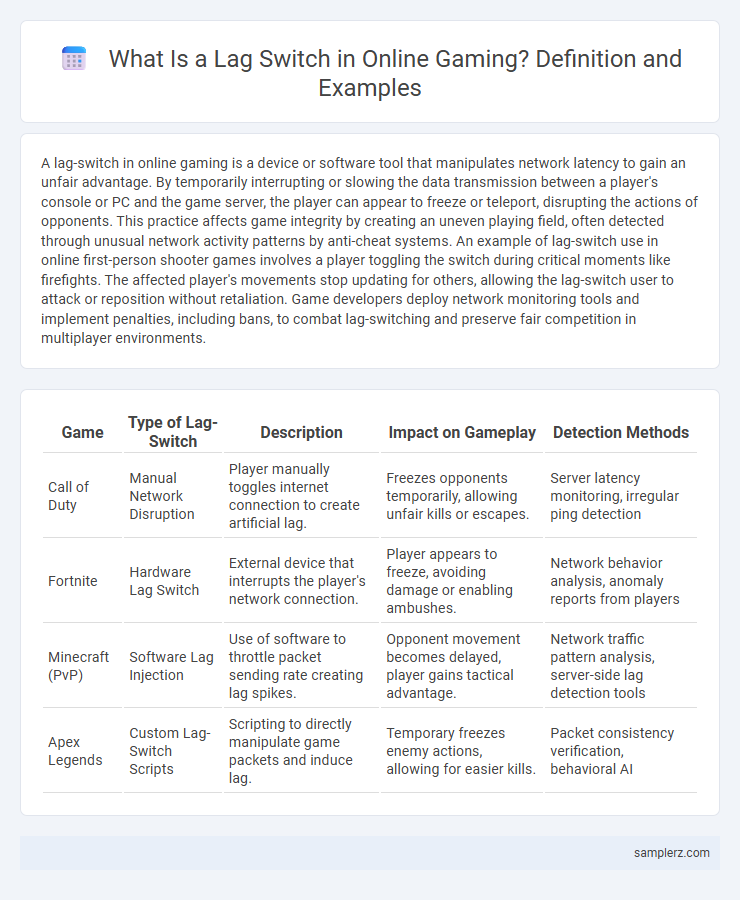A lag-switch in online gaming is a device or software tool that manipulates network latency to gain an unfair advantage. By temporarily interrupting or slowing the data transmission between a player's console or PC and the game server, the player can appear to freeze or teleport, disrupting the actions of opponents. This practice affects game integrity by creating an uneven playing field, often detected through unusual network activity patterns by anti-cheat systems. An example of lag-switch use in online first-person shooter games involves a player toggling the switch during critical moments like firefights. The affected player's movements stop updating for others, allowing the lag-switch user to attack or reposition without retaliation. Game developers deploy network monitoring tools and implement penalties, including bans, to combat lag-switching and preserve fair competition in multiplayer environments.
Table of Comparison
| Game | Type of Lag-Switch | Description | Impact on Gameplay | Detection Methods |
|---|---|---|---|---|
| Call of Duty | Manual Network Disruption | Player manually toggles internet connection to create artificial lag. | Freezes opponents temporarily, allowing unfair kills or escapes. | Server latency monitoring, irregular ping detection |
| Fortnite | Hardware Lag Switch | External device that interrupts the player's network connection. | Player appears to freeze, avoiding damage or enabling ambushes. | Network behavior analysis, anomaly reports from players |
| Minecraft (PvP) | Software Lag Injection | Use of software to throttle packet sending rate creating lag spikes. | Opponent movement becomes delayed, player gains tactical advantage. | Network traffic pattern analysis, server-side lag detection tools |
| Apex Legends | Custom Lag-Switch Scripts | Scripting to directly manipulate game packets and induce lag. | Temporary freezes enemy actions, allowing for easier kills. | Packet consistency verification, behavioral AI |
Understanding Lag-Switches in Online Gaming
Lag-switches in online gaming manipulate network latency to create unfair advantages by causing intentional delays between player actions and the game server's response. This technique interrupts the data flow, often freezing the player's position on the enemy's screen while allowing the lag-switch user to move freely, resulting in distorted gameplay and imbalance. Detecting lag-switching involves monitoring irregular ping patterns and sudden latency spikes, which disrupt the standard synchronization of online multiplayer matches.
How Lag-Switches Affect Multiplayer Gameplay
Lag-switches disrupt multiplayer gameplay by artificially delaying a player's connection, causing opponents to experience sudden freezes or teleports. This manipulation creates an unfair advantage by allowing the lag-switch user to react instantly while other players face delayed inputs. The resulting gameplay imbalance undermines competitive integrity and frustrates the gaming community.
Real-Life Scenarios of Lag-Switch Abuse
In online gaming, lag-switch abuse occurs when players intentionally manipulate their internet connection to create artificial latency, causing opponents to experience delays and disruptions during gameplay. A common real-life scenario involves a player abruptly activating a lag-switch during critical moments like boss fights or competitive matches, gaining unfair advantages such as dodging attacks or scoring kills while their opponents are frozen. This exploit undermines fair play, distorts game mechanics, and often results in account suspensions or bans when detected by anti-cheat systems.
Common Signs You've Encountered a Lag-Switch
Common signs of a lag-switch in online gaming include sudden and unexplained freezing of an opponent's character, inconsistent movement patterns, and delayed reactions to in-game actions. Players may notice that enemy avatars appear to teleport or skip frames, disrupting the flow of the match and providing an unfair advantage. These irregularities often correlate with spikes in ping or packet loss on the opponent's connection, indicating intentional network manipulation.
Popular Games Vulnerable to Lag-Switching
Popular games vulnerable to lag-switching include first-person shooters like Call of Duty and battle royale titles such as Fortnite and Apex Legends, where real-time responsiveness is crucial. These games rely heavily on stable, low-latency connections, making them prime targets for players exploiting lag-switch tactics to gain an unfair advantage by temporarily freezing their network connection. Such disruptions can result in erratic character movements and delayed actions, severely impacting competitive fairness and gameplay experience.
In-Game Behavior Typical of Lag-Switch Users
Lag-switch users in online gaming often exhibit sudden, unnatural pauses or teleportation, disrupting normal gameplay flow. Their character movements become erratic, making them difficult to predict or counter, while opponents experience delayed responses that create unfair advantages. This behavior distorts hit detection and timing, severely impacting competitive balance and player experience.
Recorded Instances: Notorious Lag-Switching Examples
Notorious lag-switching examples in online gaming include players who manipulated network connections in games like Call of Duty and Halo to gain unfair advantages by freezing their game state momentarily. This tactic was famously recorded in competitive esports tournaments, causing frustration and controversies among players and spectators alike. Such incidents highlight the need for improved detection systems and fair play enforcement in multiplayer gaming environments.
Impact of Lag-Switching on Competitive Online Matches
Lag-switching in competitive online gaming disrupts real-time data exchange, causing temporary freezes or teleportations that unfairly advantage the cheater by allowing them to act while opponents experience delays. This manipulation skews match outcomes, undermines skill-based gameplay integrity, and frustrates honest players who face unpredictable latency spikes. Persistent lag-switching leads to diminished player trust and can drive communities to abandon affected titles, threatening long-term game viability.
How Developers Combat Lag-Switch Exploits
Developers implement server-side latency detection algorithms and analyze traffic patterns to identify suspicious delays characteristic of lag-switch exploits. By enforcing strict synchronization protocols and employing anti-cheat software, game servers minimize manipulated input timings that disrupt fair play. Continuous updates and machine learning models further enhance detection accuracy, safeguarding competitive integrity in online gaming.
What to Do If You Suspect Lag-Switching
If you suspect lag-switching in an online gaming session, immediately report the player's behavior to the game's support team with specific timestamps and evidence, such as video clips or screenshots. Avoid confronting the player directly to prevent further disruption and maintain a fair play environment. Use network diagnostic tools to check your own connection stability, ensuring the issue is not due to your internet service.

example of lag-switch in online Infographic
 samplerz.com
samplerz.com